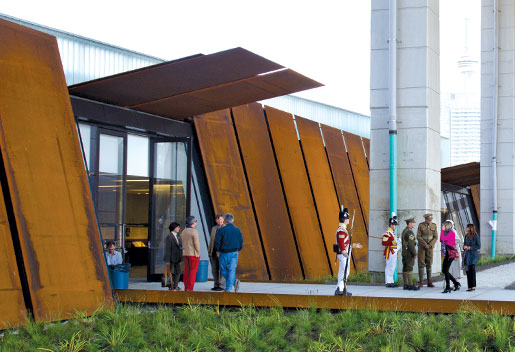The bicentennial of the War of 1812 has given a lift to Toronto’s Fork York with the addition of new visitor centre.

The 24,000-square-foot centre, which opened in November, gives the fort a new address on Fort York Boulevard and provides better access to the British-built fort now encroached upon by the Gardiner Expressway and a maze of roads leading in and out of Canada’s most populated city.
While the fort dates back to 1793, the new centre is very much part of the 21st century. Designed by Patkau Architects of Vancouver and Toronto’s Kearns Mancini Architects Inc., the state-of-the-art centre recalls the steep bluff of Lake Ontario on which the fort was originally built. That topography has changed radically with much of the original harbour filled in to provide land for various industrial facilities.
The centre is long and linear. Its west end provides space for administration. The east end holds a café, venue for receptions, lectures and other special events and a gallery where the City of Toronto can mount exhibits from its vast archives.
“The part that excites me is that this is all temperature controlled, so that we can display very valuable artifacts,” explained historical interpreter Ewan Wardle. “It is this technology which will allow us to show the original Magna Carta when it visits Canada in 2015.”
The exterior is a wall of weathered steel panels suggestive of a defensive structure. A ramp takes you to the roof of the building, which leads to the Garrison Commons in front of the old fort. Moving the administration offices from the fort to the new centre also frees up space which can now be used to show more of the fort as it was 200 years ago.
Unlike the star-shaped formations of forts such as Halifax’s Citadel, Fort York is very irregularly built to take advantage of the bluffs and cliffs along the Lake Ontario shoreline.
The fort has been rebuilt several times since Governor John Graves Simcoe established and named it. Most notably, it was destroyed during the War of 1812.
On April 27, 1813, the United States Navy arrived with 14 vessels, 86 cannon and 2,550 soldiers and seamen to attack the city. The attackers rowed ashore two kilometres west of the fort supported by the navy’s cannon. After six hours of fighting, it was clear that the British could not hold the fort. The army withdrew to the east and blew up the fort’s gunpowder supply in a devastating explosion that killed or wounded six defenders and 250 Americans. The attackers went on to loot the city and burn the Parliament Buildings.
In retaliation, the British captured Washington a year later and burned the presidential residence and the Congress.
The fort was rebuilt during the war, which ended in early 1815. It was at times neglected and at other times reinforced in light of other threats, such as the U.S. Civil War and the Fenian raids on Canada.
In 1932, the fort was formally given to the City of Toronto and converted into a historic site.
While the inside of the visitor centre is complete, the landscaping and exterior remain unfinished. The $25-million project received funding from federal, provincial and municipal governments but the Fort York Foundation is still trying to raise about $4 million to finish the project.
More about Fort York can be found at www.fortyorkfoundation.ca.
Advertisement




















